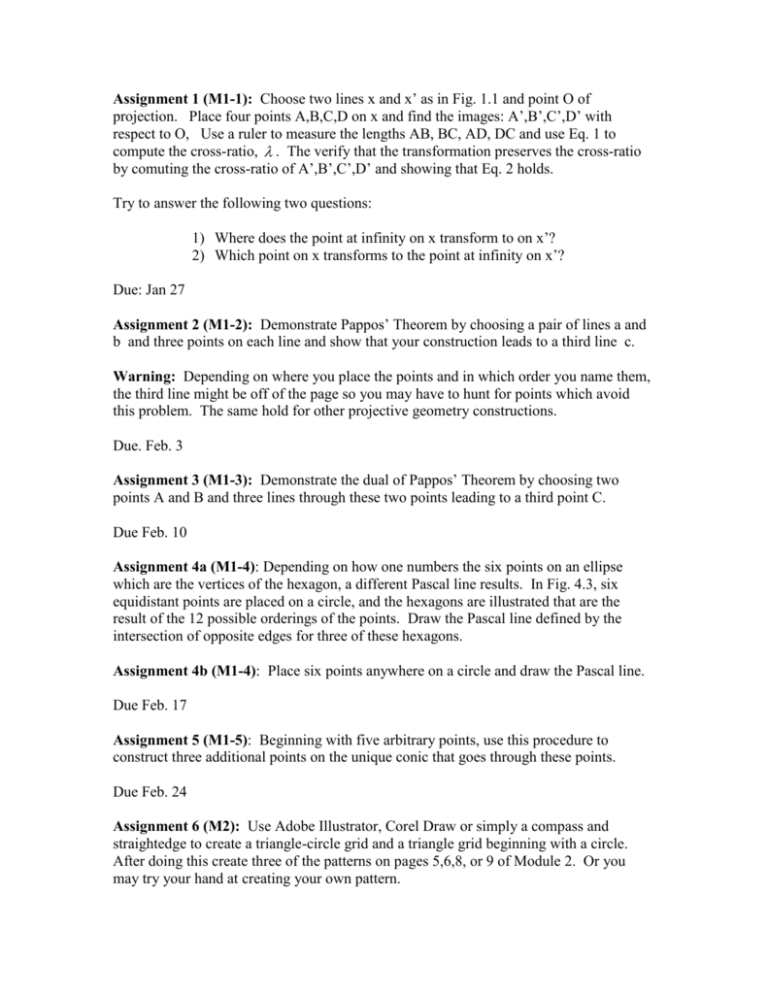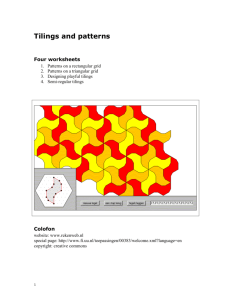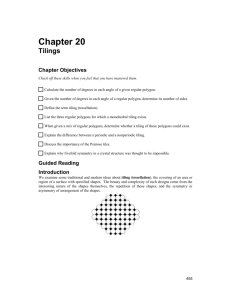Construction 1: Choose two lines x and x` as in Fig
advertisement

Assignment 1 (M1-1): Choose two lines x and x’ as in Fig. 1.1 and point O of projection. Place four points A,B,C,D on x and find the images: A’,B’,C’,D’ with respect to O, Use a ruler to measure the lengths AB, BC, AD, DC and use Eq. 1 to compute the cross-ratio, . The verify that the transformation preserves the cross-ratio by comuting the cross-ratio of A’,B’,C’,D’ and showing that Eq. 2 holds. Try to answer the following two questions: 1) Where does the point at infinity on x transform to on x’? 2) Which point on x transforms to the point at infinity on x’? Due: Jan 27 Assignment 2 (M1-2): Demonstrate Pappos’ Theorem by choosing a pair of lines a and b and three points on each line and show that your construction leads to a third line c. Warning: Depending on where you place the points and in which order you name them, the third line might be off of the page so you may have to hunt for points which avoid this problem. The same hold for other projective geometry constructions. Due. Feb. 3 Assignment 3 (M1-3): Demonstrate the dual of Pappos’ Theorem by choosing two points A and B and three lines through these two points leading to a third point C. Due Feb. 10 Assignment 4a (M1-4): Depending on how one numbers the six points on an ellipse which are the vertices of the hexagon, a different Pascal line results. In Fig. 4.3, six equidistant points are placed on a circle, and the hexagons are illustrated that are the result of the 12 possible orderings of the points. Draw the Pascal line defined by the intersection of opposite edges for three of these hexagons. Assignment 4b (M1-4): Place six points anywhere on a circle and draw the Pascal line. Due Feb. 17 Assignment 5 (M1-5): Beginning with five arbitrary points, use this procedure to construct three additional points on the unique conic that goes through these points. Due Feb. 24 Assignment 6 (M2): Use Adobe Illustrator, Corel Draw or simply a compass and straightedge to create a triangle-circle grid and a triangle grid beginning with a circle. After doing this create three of the patterns on pages 5,6,8, or 9 of Module 2. Or you may try your hand at creating your own pattern. Due: Jan 27 Assignment 7 (M2): Repeat Construction 1, beginning with a circle, to construct a square-circle or square grid and create three square-circle or square grid patterns as shown on page 11 of Module 2. Due: Jan. 27 Assignment 8 (M2): Repeat the instructions for Construction 1 and create three star patterns from pages 12 and 13 of Module 2. Due: Jan. 29 Assignment 9 (M3) : Create a square grid defining one or more of the patterns that makes up Echols’ quilt or make up your own pattern based on the Sacred cut. Due. Jan. 29 Project 1 (M3): Create your own pattern that transforms from one design to the next as Echols does in her quilt. Assignment 10 and Problem (M4): By drawing a number of star polygons, can you find a simple condition between integers n and k that will guarantee the star can be drawn in a single stroke (without taking your pencil off of the paper). Drawing a variety of 8 and 12 pointed stars will be helpful in this exploration. Jan 29 Assignment 11 (M4): Using the circle in Fig. 3 that has 360 divisions, create an interesting star design of your own. Feb. 3 Assignment 12 (M4) Use compass and straightedge to construct a star pentagon and a star octagon (see Module 4). To do this you will have to divide a line segment into the golden section : 1 (see page 83 of Connections) for the pentagon and construct a sacred cut of a square for the octagon. For details see Module 4) Assignment 13 (M4): Construct a Brunes star and color the regions in such a way as to bring out its power. Assignment 14 (M5) or Project 1 : Use the geometric properties of the Roman system to create a number of S,SR, and RR rectangles at three different scales and use them to create an interesting tiling design. Add color to your design. One response to this construction, shown in Fig. 5, was carried out by Mark Bac. Assignment 15. Game (M6): Use the strategy in Module 6 to play Wythoff’s game with a friend. Assignment 16 or Project 3 (M7): Create a number of GT1’s and GT2’s at three different scales and use them to create a tiling design. Two such designs are shown in Fig. 5, Elyses Dragon by Elyse Grady and the other in Fig. 6 by Eileen Domonkos. Assignment 17 (M8): Use this method of extraction to find the gcd of the following rectangles: a) 240:72 b) 55:34 Find the least number of congruent squares needed to tile the rectangles Assignment 18 (M8): Draw the graph for the tiling in Fig. 9c of Module 8. Assignment 19 or Project 4 (M8): Distort the configuration of rectangles shown in Fig. 12 of Module 8 so that the outer rectangle is tiled by non-congruent squares. First decide which rectangle will be transformed into the smallest square, then follow the procedure outlined above. After determining the size of the squares, carry out the tiling with the care of an artist or designer. Color your tilings using the fewest number of colors possible so that no two squares sharing the same edge are the same color. Can you rearrange the squares in your tiling so as to tile the outer rectangle in a different way? Assignment 20 or Project 4 (M8): Try your hand at discovering a tiling not represented here. Be forewarned that many diagrams will result in impossible results; both variables will be equal to 0, or one variable or variable expression will be negative. Three additional possibilities are given in Fig. 13. Assignment 21 (M9): Create a hierarchal pattern from the F-sequence. Your fundamental pattern can be dots, lines, or anything else of your choosing. Order your modules to give a geometrical rendering of the F- sequence. It might be useful to use graph paper to help organize your work at first. See pages 77 and 78 in Connections for examples. Assignment 22. Homework on the Modulor (M9): Do the problems in Section 2 and 3 of Module 9. Assignment 23 or Project 5 (M9): Create three different breakdowns of a 2 3 2 3 square and tile the square in three different ways using each breakdown. Finally tile a 5 inch by 5 inch square to within a quarter inch tolerance using rectangles from the Red and Blue sequences. One example of this project is shown in Fig. 9. Assignment 24 (M10): Use the whirling squares to construct an approximate logarithmic spiral when k = by the method shown in Appendix 1 of Module 10. Assignment 25 (M10): Follow the instructions in Appendix 2 of Module 10 to draw the four logarithmic spirals traversed by Tom Pizza’s trained turtles Assignment 26 (M10): Construct a Baravelle spiral and color it to bring out its power. Details plans are given in Appendix 3 of Module 10. Assignment 27 (M18): On a piece of graph paper, create a 3-vector star and use it to create a 3-zonogon (hexagon with opposite sides parallel and equal). Create a tiling with at least six 3-zonogons in which the length of one of the vectors of the vector star is changed in each hexagon of the tiling. You will have the image of a 3-D polyhedron called a rhombic dodecahedron. Assignment 28 (M18): Create a regular octagon (4-zonogon) from a 4-vector star. Tile the octagon with (4)(3)/2 = 6 parallelograms in two ways. Do the same for a regular decagon (5-zonogon) and tile it in two ways with (5)(4)/2 = 10 parallelograms in two ways. You will have the image of a 3-D polyhedron called a rhombic icosahedron. Assignment 29 (M13, M13-2): Read Module 13 to see how to construct a kite and a dart. On page 205 of Module 13-2 there are instructions to create a Girih tile called a “bowtie” using 3 darts and 4 kites and a tile called a “bobbin” using 3 darts and 7 kites. Now create a number of replicas of the bobbins and bowties. Bobbins and bowties can then be used to create other tiles. For example in Fig. 9 you can see how 2 bowties and 1 bobbin create a star and 3 bobbins and 1 bowtie crate an octagon. Fig.10 you will see several other examples of super-girih tiles created from bobbins and bowties. In any tiling such as the one in Fig. 9, the ratio of bobbins to bowties is approximately the golden mean or 1.618. Another discovery of the author of the article in Module 13-2 is that if you crate a ring of decagons where the decagons are separated by bowties (see Fig. 11) whenever you get a closed area if can always be tiled by bobbins and bowties with no gaps. You assignment is to create a tiling using bobbins and bowties that you created from the kites and darts. This assignment can be made into a very nice project.










